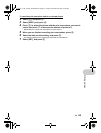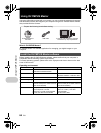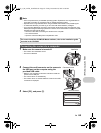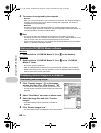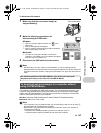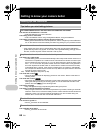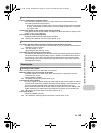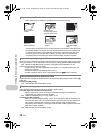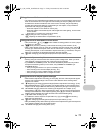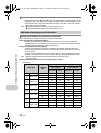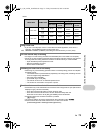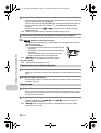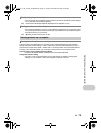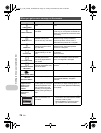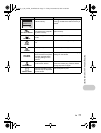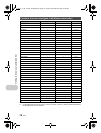
EN 71
Getting to know your camera better
• The reason why there are differences between the colors in a picture and the actual colors
taken and the actual color is the light source illuminating the subject. [WB] is the function
that allows the camera to determine the correct colors. Normally, the [AUTO] setting
provides the optimal white balance, but depending on the subject, it may be better to
experiment with changing the [WB] setting.
• When the subject is in the shade on a sunny day
• When the subject is illuminated by both natural light and indoor lighting, such as when
near a window
• When there is no white in the center of the frame
g “WB Adjusting the color of a picture” (P.39)
“> Adjusting the white balance compensation” (P.43)
• Take pictures with Z or a in s mode. Suitable for taking pictures on a sunny day at
the beach or in the snow.
g “s Shoot pictures by selecting a scene mode according to the situation” (P.18)
• Often, bright subjects (such as snow) turn out darker than their natural colors. Adjust F
toward [+] to make these subjects closer to their real shades. Conversely, when you are
shooting dark subjects, it can be effective to adjust toward the [–]. Sometimes, using the
flash may not produce the brightness (exposure) that was intended.
g “F button Changing picture brightness (Exposure Compensation)” (P.22)
• Panning along the camera central axis reduces picture misalignment. When you shoot
close subjects, panning along the axis of the lens gives good results.
• In [COMBINE IN CAMERA1] mode, the camera automatically detects its own position
except for the following cases (In such cases, use [COMBINE IN CAMERA 2] or
[COMBINE IN PC].):
• when panning the camera in a quick or unsteadily manner.
• when shooting a low contrast subject (blue sky, etc.).
• when shooting a moving subject framed in full screen.
• when panning the camera with no images on-screen.
• When Shadow Adjustment Technology is set to [ON], the face of the subject will appear
brighter even against backlight. This function is also effective when shooting indoor
pictures from outdoor.
g “f Brightening the subject against backlight (Shadow Adjustment Technology)” (P.25)
• With [METERING] set to [n], the picture can be taken based on the brightness of the
subject in the AF target mark area without being affected by the light in the background.
g “METERING Changing the area for measuring the brightness of a subject” (P.41)
• Set the flash to [#] (Fill-in flash) to activate fill-in-flash. You can shoot a subject against
backlight without the face of the subject appearing dark. [#] (Fill-in flash) is effective for
shooting against backlight and under fluorescent and other artificial lighting.
g “3# button Flash shooting” (P.23)
• It is effective to set the exposure compensation to [+] by pressing F when shooting
against strong backlighting.
g “F button Changing picture brightness (Exposure Compensation)” (P.22)
• With [AF MODE] set to [FACE DETECT], the face of the subject will be given due exposure
even against backlight and it will appear brighter.
g “AF MODE Changing the focusing area” (P.41)
Taking pictures with the correct color
Taking pictures of a white beach or snow scene
Misalignment of panoramic pictures
Taking pictures of a subject against backlight
d4364_e_00_unified_bookfile.book Page 71 Friday, December 28, 2007 4:06 PM



